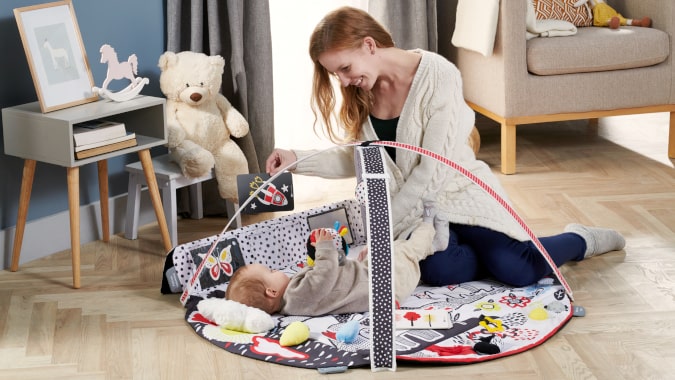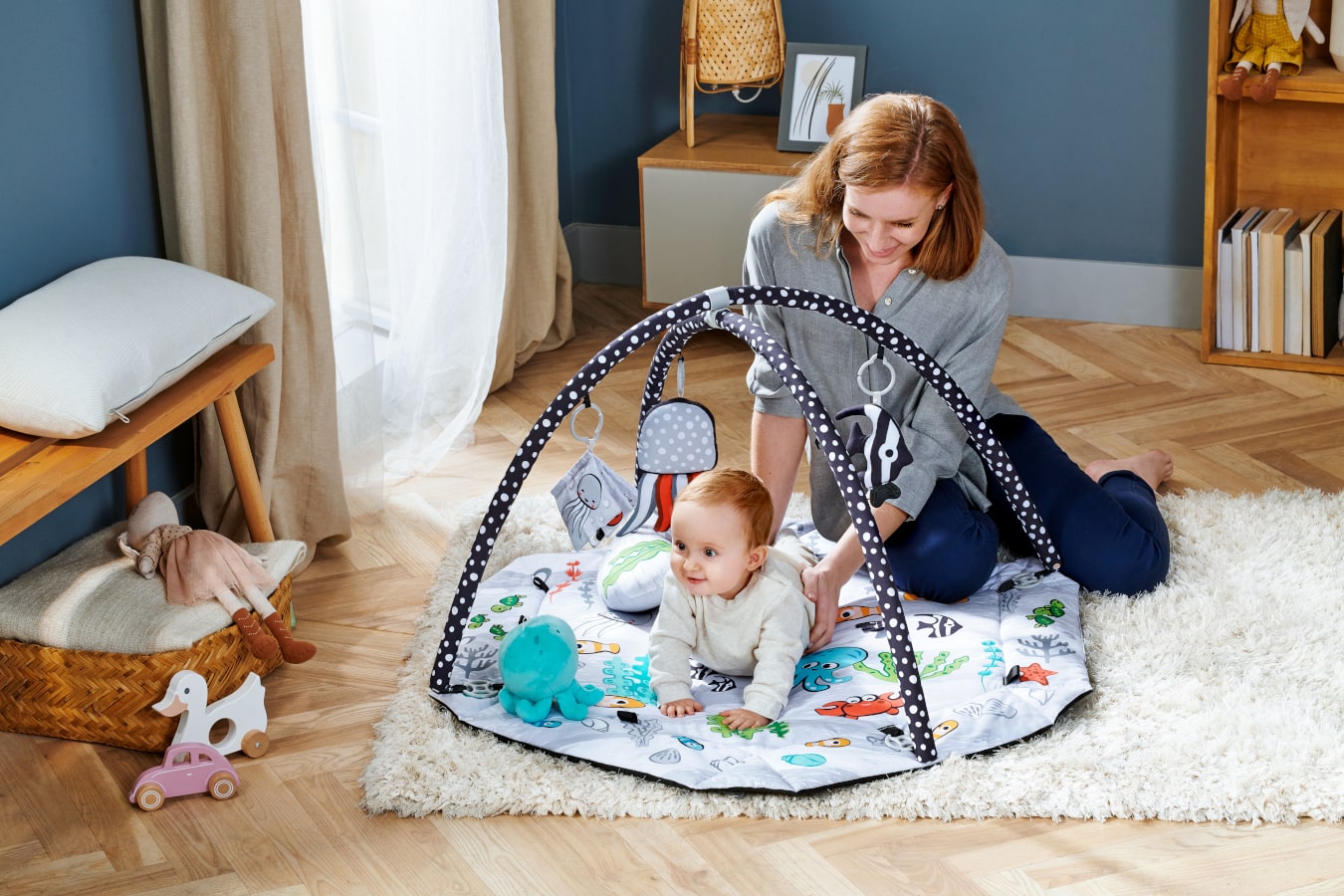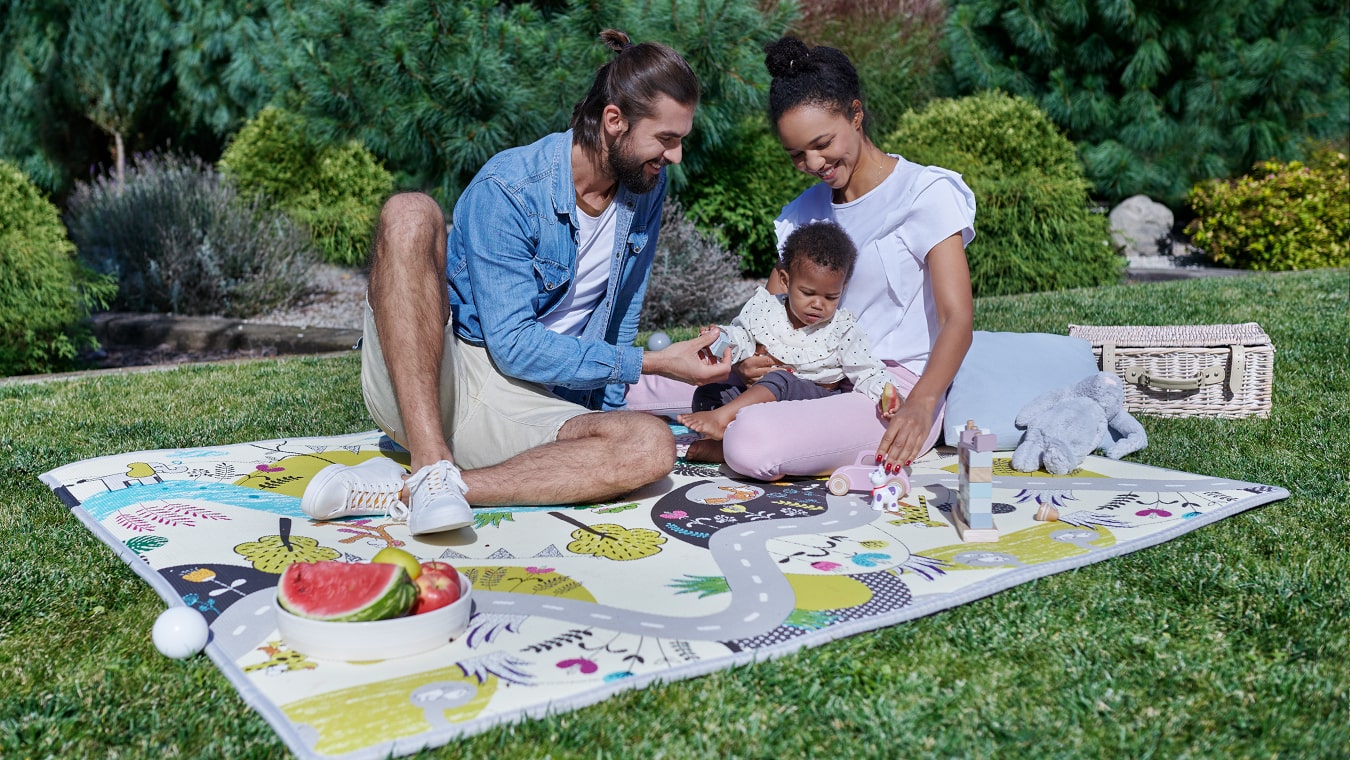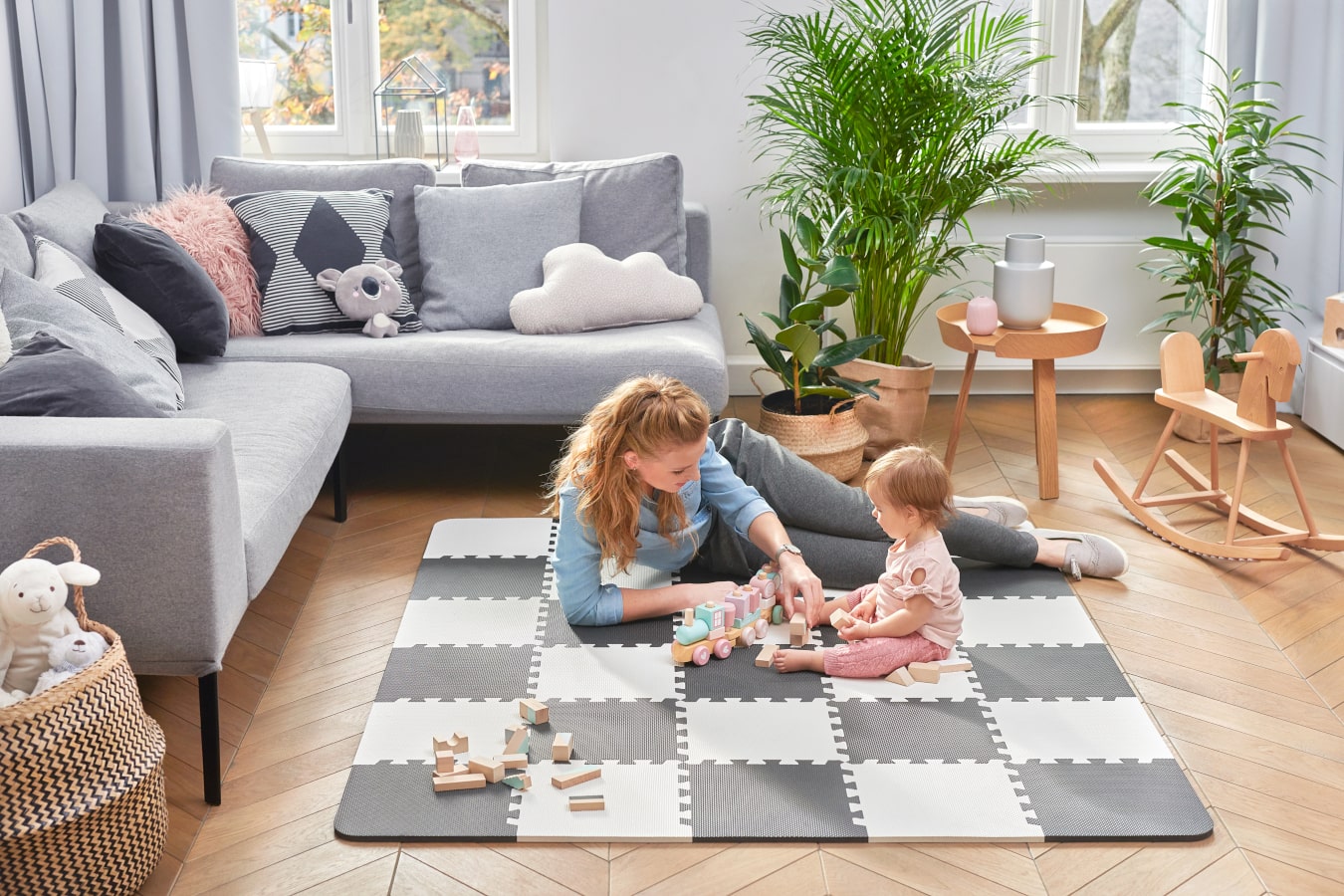Educational mats and jigsaw puzzles for children – how to choose them and when to start using them

Educational mats offer a safe place for your child to play, a space that supports your little one's development, and a whole range of various functions that stimulate your baby's senses. If you're wondering if an educational mat is a good idea, this article should convince you.
Educational mats – what are they?
Do you want to provide your child with a safe place to play that's also a creative space supporting their development? An educational mat plays both of these roles. You'll find many different versions – foam mats, fabric mats, mats for younger children and mats for older kids. They're great as both an alternative to a rug and as support for your littlie's development. Depending on the type, mats stimulate in various ways: bold colours, textures, and accessories that you can attach. Thanks to this, your youngster will be exposed to a range of different stimuli, which will prevent them from getting bored.

Types of educational mats
The simplest breakdown of mats features fabric ones, which resemble small rugs, and foam ones, which are thicker and sometimes look like a jigsaw puzzle. But that's only the beginning, because educational mats are varied and have rich colours, shapes, accessories and functions. When choosing, consider the age at which your littlie can start using the mat. Many, such as our 4SMART, can be used already from birth.
Educational mats with a bar
Educational mats with a bar are fabric mats accompanied by a bar spanning across the base. This is one of the most popular types of mats. They include rich shapes, colours and accessories. A bar is there for you to hang different toys that develop your child's senses, such as mirrors, music boxes, teethers, rattles and many, many more. Mats with a bar encourage babies to reach out their hands, grab the toys, pull the toys towards themselves and bite them. An example of a mat with a bar is our SEALAND mat, which also acts as a dry pool with colourful balls (included) – this is perfect for children who are able to sit up. As you can see, this mat will last your baby for much longer than just the first few months of life.
Fabric educational mats
Fabric educational mats are different to ones with a bar in that they don't have – yes, you got it – a bar. But this doesn't mean that they don't come with accessories, because these can be attached in other ways, for example, directly to the mat. They have a slightly different function – the main point of such mats is that they are to provide a soft, pleasant and safe place to play. This type of mat is usually larger than ones with a bar. This means that when your littlie grows out of it, it can easily be used as a blanket or throw. Some fabric educational mats are equipped with a non-slip layer, meaning your child can safely run on it.
Educational mats with tags
Educational mats with tags are a feast of colours, sizes and shapes. You can choose from among a huge range of attractions that attach to the mat. The most important feature, however, is the tags, which offer different experiences with textures, colours and materials. The tags are usually found on the edges of the mat, and their function is to stimulate your littlie to develop hand-eye coordination – to play with them, your youngster must be determined and either crawl or pull themselves to the edge of the mat.
Educational floor mats
Educational floor mats are an attractive alternative to a rug that's easy to transport. You can place them permanently in your baby's room, but because they're extremely lightweight, you can roll them up and take them wherever you like. They're great as a play space but also as a place for learning to crawl or walk. A great benefit is that they're suitable for newborns. Some of them are made of foam – they're non-slip, soft and provide good insulation against the floor. Our MATTY and LUNO are examples of foam mats. The latter is in the form of large jigsaw puzzle pieces, which are very easy to put together and transport thanks to the included bag.

What are the benefits of educational mats?
The benefits of education mats are first and foremost their very beneficial impact on your littlie's development, particularly on their psychomotor development. It's good to support the senses and body of children using mats already from three months. For this purpose, the best ones are mats full of colours, different shapes and toys. At this age, your child is constantly seeking new experiences, and that's why a wide range of shapes and tones will be ideal (don't forget, though, that very young children notice mainly contrasting colours). The colours activate their sight, while the textures develop their sense of touch. Remember that mats can also have rattling elements, music boxes and squeaky toys, which develop the sense of hearing.
At the same time, an attractive mat can also be extremely useful for the parents, who'll have a place to put their littlie to be safely entertained with interesting accessories. Both fabric and foam mats are also a space to help you organise your baby's room – this will be a separate space where your child manages their toys.
A bouncer or mat – which one is better?
Are you wondering whether to buy a bouncer or an educational mat? You don't know which option will be better? Everything depends on your needs and preferences. Bouncers are better at helping parents, while mats are much more comfortable and attractive from the point of view of your little one. This is because they're mobile – you can always take a mat with you or move it from the bedroom to the kitchen, bathroom or wherever you need it to be. But you'll likely not be able to take a larger mat into a small bathroom. Bouncers have a safety harness, and are comfortable and safe, so if you pop your child in one, you can be sure that they'll sit safely in one place. Many bouncers offer various attractions, such as toys on the bar, melodies and vibrations. A mat has one main advantage over a bouncer – it doesn't restrict your littlie. Your child will feel freer, isn't squashed into a seat, and can lie down in comfort, and this is the position that doctors recommend. So if you want your youngster to be comfortable, a mat is ideal.
What should you look for when choosing an educational mat for your baby?
When buying an educational mat, you need to check all of its features to make sure that the model you choose meets all your expectations. Mats differ in both their appearance, colours, sizes and material they're made of, as well as their functions and included accessories.
Colour scheme
When looking at mats, you'll see that in terms of colours, they fall into one of two groups: there are very colourful mats that are full of bold colours and fancy patterns. The other group includes mats in two or three colours, but the colours will be contrasting, for example, black and white, or black, white and red. The first group is ideal for stimulating sight for slightly older babies, while contrasting mats are better for newborns, in whom this sense is still poorly developed.
Method of manufacture and materials used
Educational mats can be either fabric or foam. Irrespective of which type you choose, make sure you check the quality of craftsmanship. The amt shouldn't have any protruding elements that could pose a risk to your baby. For fabric mats, make sure that they're sewn correctly and are durable enough. It's also important that the material used feels pleasant for your littlie and holds appropriate certificates. In addition, it shouldn't be too slippery or soft, otherwise your youngster will sink into it, which will restrict their movements too much. For your convenience, make sure the material is easy to keep clean – for example, using a cloth (for foam mats) or machine washing (for fabric mats).
Safeguards
When buying a mat, you should also of course be guided by safety. Some models offer special safeguards, such as non-slip protection, thanks to which your littlie will be able to confidently walk on them without worrying that they'll fall over. In addition, such a mat grips better to the floor and gives greater stability when your baby starts rolling over or trying to crawl. It's good to see if foam mats, such as LUNO, have a smooth-enough finish to prevent tripping over protruding jigsaw puzzle elements of the mat.
Size
You might think that the bigger, the better. Yes, when choosing a mat, it's good to check that it's big enough to not limit your littlie's movements, so that they have room to freely move around, roll over and crawl. But everything depends on your needs and the conditions in your home. Very young children don't need very big mats – all you need is a bit of room that they're able to slowly explore. Smaller mats are also great if you don't have a lot of room in your home – when you take this into consideration, it may turn out that you won't have room to unroll the mat. A good solution in this situation is a jigsaw puzzle mat, because you can put it together in whatever shape you like.
Additional elements
Manufacturers are racing to offer accessories that you won't find anywhere else. This means you can pick and choose between educational mat accessories. They include simple tags in different colours and textures, and more-complicated entertainment, such as squeaky toys, music boxes, and electronic gadgets that play music and light up. But that's not all – mats with toys include a wide range of elements that you can attach to the bar, such as mirrors, rattles, teethers, plush toys, etc. All of this so that your littlie gets enough developmental stimuli. Remember, though, that in this case, more isn't necessarily better. Elements that are too loud or bright may overstimulate your child, leading to irritation and distraction. Everything needs to be done in moderation. Our 4SMART mat has this balance – it offers a wide range of accessories, such as plush toys, contrasting cards, tags, rustling elements that stimulate the sense of touch, and even a large sensory ball. You don't have to worry about overstimulation, because they're subdued and chosen appropriately to the cognitive abilities of children.
Functionality
When choosing a mat, don't forget about yourself. It's meant to be functional, fold easily, lightweight, handy and easy to move and store. Our TIPPY mat is all of these – it's durable, flexible and has soft bars, making it easy to roll up. This means that you can effortlessly transport and store it in a small space. Check the manufacturers' descriptions and mat features such as thickness, which determines the degree of insulation against the floor, and easy cleaning. You'll find these benefits in our LUNO multi-functional foam mat, which is thick (1.2 cm) to provide great protection from the floor, and is easy to clean – it's waterproof and you just need to wipe it down with a cloth. It also features a non-slip surface and is in the form of attractive jigsaw puzzle pieces that can be assembled even in three dimensions! An interesting addition is, for example, the special cushion, which increases your littlie's comfort while they're on their stomach. This is available in our SMARTPLAY set.

A contrasting mat – the best product for little children
If you're looking for something that can be used from birth, why not buy a contrasting mat, which your newborn will definitely love! Why? Because it features colours that your baby's not-yet-developed eye will recognise. According to paediatricians, newborns are best at differentiating between three colours – black, white and red. That's why their eyes like to follow objects in these colours. But that's not enough. It's good for these shapes to be large enough and have sharply drawn on edges. These types of patterns should be on contrasting mats that are suitable for little children, and our 4SMART contrasting mat is a great example of this.
Whom are educational mats best for?
Educational mats will be loved by children – because they're full of attractive toys and new experiences – as well as adults – because they'll provide a space where your little one is safe and gets the right amount of stimulation. There are mats on the market that are recommended for newborns – if this is what you want, the best option is a contrasting mat. A classic educational mat is best for children who are at least three or four months old. This is when your baby starts to roll over from their back to their tummy and gets more mobile. A well-chosen mat will be more extensive and can last a long time, both as a place full of attractive gadgets and a separate space for your littlie to play – their little kingdom.
